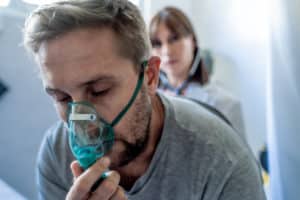Chest Injury
Home » Personal Injury Resources » Types of Injuries » Chest Injuries

Your chest protects vital organs like your heart, lungs, and major blood vessels. It also helps you support your head and upper body. And along with your back and shoulders, it provides strength and movement to your arms.
A chest injury can range from an annoying but minor muscle strain to a penetrating injury that could kill you. It could interfere with your ability to perform your daily activities like showering and dressing. An injured chest could also prevent you from earning a living.
Here’s an overview of the causes and effects of a chest injury, along with a discussion about the compensation you can obtain for this kind of injury.
Table of Contents
What is the Structure and Function of Your Chest?

Your chest includes the musculoskeletal structures that form and protect your chest cavity. According to this definition, your chest includes your chest wall but does not include the organs inside your chest.
Doctors and scientists also refer to your chest as your thorax and the chest cavity as your thoracic cavity. An animal’s thorax includes the section of the body between the head and abdomen. In humans, the thorax starts at the shoulders and runs down to the diaphragm just below the ribcage.
Bones and Cartilage
Your chest includes several sets of bones. The top of your chest includes your shoulder blades and your collarbones.
The spine runs along the back of your chest. Your thoracic spine includes 12 vertebrae. The thoracic vertebrae sit between the cervical vertebrae in your neck and the lumbar vertebrae in your lower back.
You have 12 pairs of ribs. These ribs attach to the thoracic vertebrae in your back. In the front of your body, the top seven pairs of ribs attach to your sternum with cartilage. Doctors refer to these as “true ribs.”
The next three pairs of ribs attach to the true ribs via cartilage. Since these ribs do not attach directly to the sternum, doctors refer to them as “false ribs.”
The bottom two pairs of ribs only attach to the spine. Doctors refer to these ribs as “floating ribs” because they do not attach to the sternum or the other ribs.
The cartilage that connects the sternum, true ribs, and false ribs is tough and smooth. This cartilage provides structure while still flexing so you can expand your chest to breathe.
Muscles, Ligaments, and Tendons
Ligaments hold the bones of your chest together. For example, ligaments join your ribs with your spine. These ligaments provide structure by holding the bones in place. They also provide flexibility by stretching when you bend, twist, and expand your chest.
Several large muscles run through your chest. These muscles provide strength and motion. They help you carry your weight and expand your chest when you breathe. They also provide leverage to lift or lower your shoulders, arms, and head.
Tendons anchor these muscles to the bones. Muscles in your chest connect your head, neck, back, shoulder blades, ribs, collarbones, and sternum. Intercostal muscles also sit between the ribs to expand your chest so you can breathe.
What Causes a Chest Injury?
Chest injuries are often caused by these three things:
Penetrating Forces
Penetrating forces can pierce your chest wall. For example, a penetrating injury can result from a workplace accident where a machine propels a piece of metal into your chest.
Penetrating injuries can result in torn muscles, tendons, ligaments, and cartilage. They can also create a hole in your chest wall that allows air or blood to leak into your chest cavity.
Blunt Forces
Blunt forces impact your chest without penetrating your chest wall. A seat belt injury during a car accident is one example of a blunt force chest injury. Blunt forces can bruise muscles, fracture bones, and tear soft tissue.
Hyperextension
Hyperextension injuries happen when your chest gets stretched out of its normal shape. If you were to catch yourself during a slip and fall accident, you might hyperextend the muscles, tendons, and ligaments in your chest.
What Are the Chest Injury Types?
Chest injuries can take many different forms depending on the tissue you injure. Trauma to your chest can cause injuries such as:
Chest Strains or Sprains
Strains happen when the muscles and tendons in your chest get stretched or torn. These injuries often happen in penetrating, blunt force, or hyperextension injuries.
Symptoms of chest strain include:
- Pain
- Stiffness
- Muscle spasms
- Weakness
- Inflammation
Sprains happen when the ligaments in your chest get stretched or torn. Chest sprains usually involve the ligaments that hold your ribs to your spine.
Symptoms of chest sprains include:
- Pain
- Joint instability
- Limited range of motion
- Bruises
- Popping sensation during the accident
- Inflammation
Chest strains and sprains usually heal with rest and icing within four to six weeks after the accident. Doctors generally avoid surgery to repair a chest strain or sprain.
Dislocated Rib
If you tear the cartilage in your chest or stretch the ligaments in your back, your ribs can move out of place. As they move out of place, they can irritate and inflame nearby nerves causing pain, particularly when inhaling or exhaling.
Once the swelling from your dislocated rib goes down, the cartilage and ligaments can heal and pull your rib back into place.
Fractured Rib
A fractured rib can cause pain and bruises. A fractured rib will usually heal on its own within eight weeks after the injury. Doctors used to tape your chest to immobilize a fractured rib, but they now avoid this practice because shallow breaths increase the risk of pneumonia.
Flail chest, on the other hand, is a particularly dangerous form of rib fracture. This condition occurs when your rib fractures into at least three pieces. The loose fragment causes part of your ribcage to move in the opposite direction from the rest of your chest when you breathe. Flail chest will kill you without emergency treatment.
How Do You Get Compensation for a Chest Injury?
Compensation for a chest injury will depend on the cause of the injury and the impact the injury had on your life. If your injury resulted from someone else’s negligence, you could recover compensation for your medical expenses, lost wages, and pain and suffering in a personal injury claim or lawsuit. Chest injuries can interfere with your ability to stand, lift, and carry objects. To discuss the compensation you can seek for your chest injury, contact the M&Y Personal Injury Lawyers for a free consultation.
